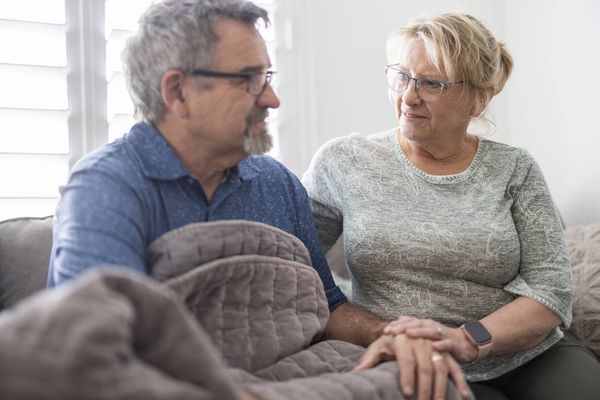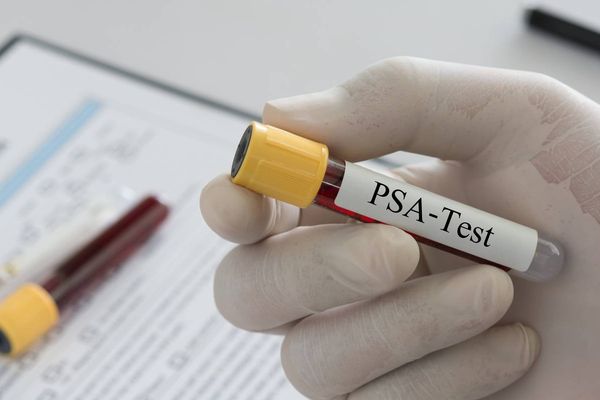November is National Family Caregivers Month.
Lymphedema is a build-up of a watery fluid in your body called lymph, causing chronic swelling, usually in an arm or leg. Lymph, which supports your overall health and your immune system function, flows from your tissues into the lymphatic vessels, and then through a cluster of nodes (lymph nodes) that filter out bacteria and other unwanted substances.
If any of the lymph nodes are removed or damaged as part of cancer treatment, the remaining nodes have to work harder to filter the lymph. They can then become inflamed or even blocked, so the lymph backs up into the tissue.
There’s no cure for lymphedema, but if you’re actively involved with your partner’s medical care, it’s helpful to know what you can do to help him manage the condition.There are actions you can take to help reduce your partner’s swelling, prevent infection, relieve discomfort and help improve their mobility.
“We want to make sure the [caregiver] is also aware of what’s going on, so that they can help with either massaging and helping the spouse, or arranging some ways of getting care,” said Pragnan Kancharla, MD, a medical oncologist and hematologist at MedStar Franklin Square Medical Center in Maryland.
Speaking with a specialized lymphedema specialist is helpful. But not everyone has access to one.
If your partner does develop lymphedema, it’s important to understand how you can help.
Lymphedema with prostate cancer
Where lymphedema occurs depends on where the affected lymph nodes are. For people with prostate cancer, lymphedema could affect the legs, penis, scrotum or lower body overall.
Symptoms of lymphedema could include:
- Swelling
- Tight, sore skin
- Scaly and thickened skin, called hyperkeratosis
- Small blisters and bumps on the skin
- Fluid (lymph) leaking from the skin
Is your partner at risk for lymphedema?
A radical prostatectomy, which removes the prostate and pelvic lymph nodes, is the most common cause of lymphedema among people who have prostate cancer. Radiation sometimes damages the nodes too. Men who have both surgery and radiation therapy are at higher risk of lymphedema, and the more nodes affected, the higher the risk.
Lymphedema could also be caused by:
- Infection or other complications at the lymph node surgery site
- A build-up of fluid near the wound, called a seroma
- Advanced cancer
Diagnosing and starting treatment for lymphedema in the early stages can slow down its progress. Moderate to severe swelling can make it hard to walk and perform everyday activities.
Caring for someone with lymphedema at home
The simple act of elevating the affected leg can be quite helpful, Kancharla said. And doing some simple exercises can also help. Exercises move the lymph and encourage good range of motion around the joints — something that could become difficult if there is too much swelling.
A healthcare provider (HCP), physical therapist or lymphedema specialist can show you and your partner the best exercises to do. Many can even be done while sitting down.
Some exercises that are good for lymphedema include:
- Marching on the spot or while sitting
- Knee extension while seated, raising the leg and extending the knee
- Toe extensions, also while seated, lifting your toes up as far as you can, then relaxing them
Here are some other tips you could assist your partner with to help reduce the swelling caused by lymphedema:
- Manage weight: Having overweight or obesity can worsen lymphedema in the legs. It can also increase the risk of a skin infection called cellulitis. You or your partner could speak with a dietitian if you need help coming up with a healthier diet plan or if your partner could use some help getting to a healthy weight.
- Decrease salt intake: Salt makes your body retain fluid, something to avoid if you have lymphedema. If you are preparing your partner’s food and flavor is a concern, many dishes taste good if you add fresh herbs instead of salt.
- Drink plenty of water: The goal of lymphedema treatment is to reduce the fluid, but it’s still important for your partner to drink at least eight 8-ounce glasses of water each day. This helps flush out the unwanted fluids.
- Wear loose clothing: Encourage your partner to avoid tight pants and socks (especially at the band). Well-fitting shoes are also important to prevent blisters or sores, which could become infected.
- Protect skin: Remind your partner to keep his skin clean and dry to help prevent infection. If you help him with cutting toenails, be sure not to cut his cuticles. Also suggest long pants for gardening, walking or doing any activity where the legs could get scratched. Use sun protection (SPF 30 or higher) and insect repellents to stop bug bites.
- Don’t ignore skin injuries: Treat any injuries to the skin right away by cleaning them, applying antibiotic ointment and covering them. Keep an eye on the site for any signs of infection, like redness or warmth. This will help reduce the risk of infections, cellulitis and a serious complication called sepsis.
If your partner needs more help
If the first steps at home don’t work, there are other options. Your partner’s HCP can also refer him to other healthcare professionals, like occupational or physical therapists.
- Compression stockings: According to Kancharla, sometimes patients must use compression stockings or massage for relief in addition to elevating the leg. Compression stockings are specially fitted for the leg to prevent fluid build-up in the tissue. A prescription is needed and the stockings must be fitted by a professional. Since these stockings can be hard to put on, ask the provider to show you the best way to do this and for any tips or tricks to make it easier. Compression stockings shouldn’t be borrowed from someone else because unfitted ones could worsen lymphedema.
- Lymphatic drainage massage: Your partner’s HCP might recommend a special type of massage called manual lymphatic drainage. This isn’t the type of massage most of us are used to. A lymphatic drainage massage uses a gentle pressure to move the lymph fluid from the tissue toward the lymph nodes. Physical therapists and specially trained massage therapists and other HCPs can perform these massages. They can also be done at home by you or your partner, but it’s important to learn the technique from a qualified person.
- Intermittent pneumatic compression: If the lymphedema is more severe, your partner’s HCP might prescribe intermittent pneumatic compression, which is done with a pump. A compression sleeve is wrapped around the leg and then inflated and deflated, stimulating the circulation. How long each session is depends on what the HCP recommends.
Managing costs
Exercises, doing lymphatic massages and eating a healthy diet are things that most people can do at home, but not everyone can easily afford lymphatic massages done at a clinic or office, compression stockings, or pumps. Medicare does cover lymphedema compression treatment items though, as do some private insurance companies. Private insurance might also cover massages. It’s important that your partner apply for assistance if he needs it.
With you and your partner working as a team, you can help lessen anxiety and stress for both of you. By understanding your partner’s condition and treatment, you can also act as his advocate if necessary. “Lymphedema [with prostate cancer] is extremely rare now, something that we don't see as often,” Kancharla said. “But if someone does have lymphedema, especially related to the tumor or cancer itself or post-surgery, we do have a lot of resources.”
This educational resource was created with support from Bayer and Merck.
- Caring for Someone With Cancer Is Emotional — and Expensive ›
- How Becoming My Husband’s Caregiver in My 30s Changed My Life ›
- Have a Male Partner? Here’s What You Need to Know About Prostate Cancer ›
- My Husband’s Prostate Cancer Is Terminal, but that Hasn’t Put an End to Our Love for Each Other ›
- Encouraging Your Partner to Get Screened for Prostate Cancer ›
- Polly’s Partner, Pete, Has Prostate Cancer - HealthyWomen ›





